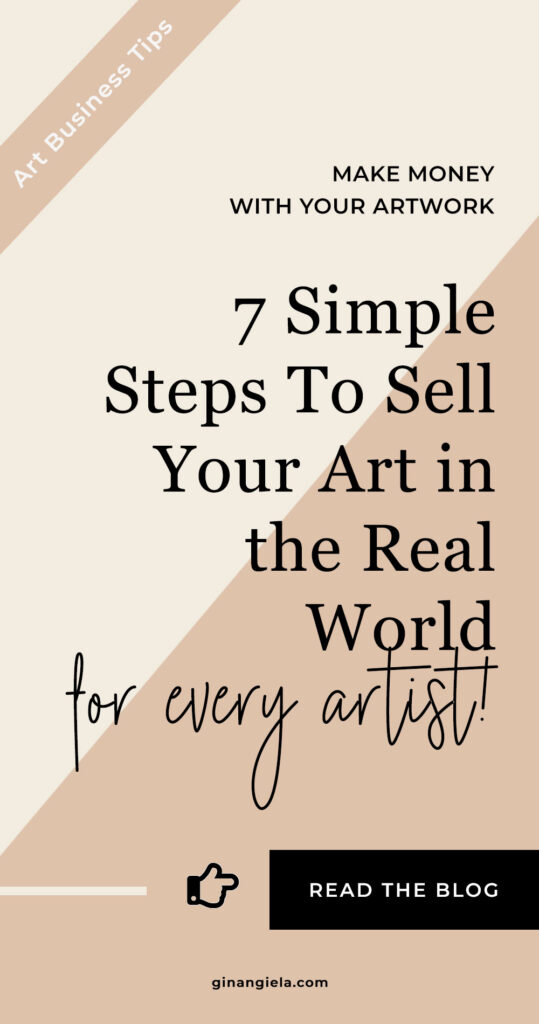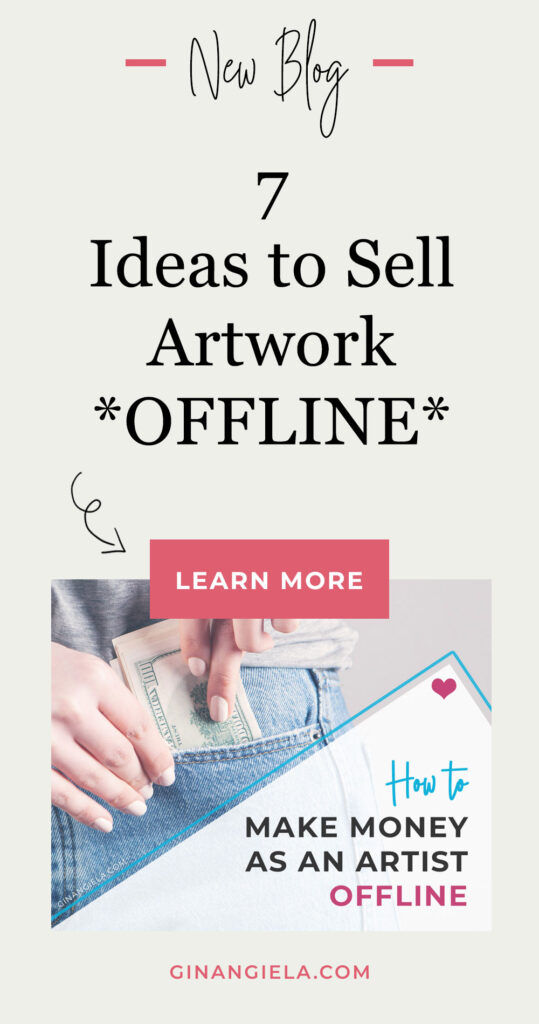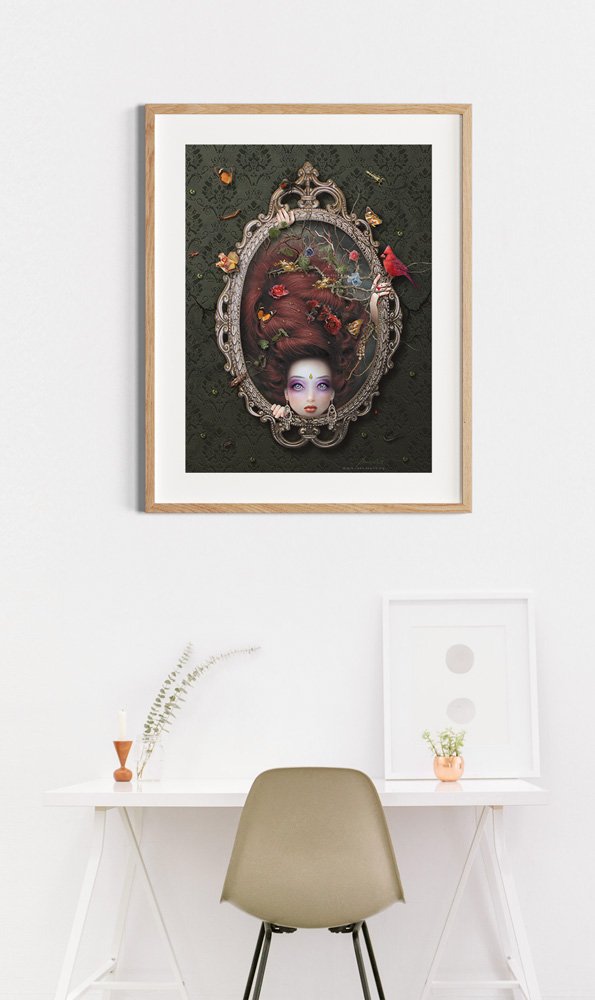Even though the internet is an incredibly powerful medium to get the word out about your art, it is totally possible to sell your art offline as well. There are not as many opportunities and it is a bit harder to get started, but it can be done. Here’s how to make money as an artist offline!

Although the internet is a powerful medium to showcase and sell your art, the real world is still a fantastic place to make money as an artist offline.
As a matter of fact, the offline options are somewhat limited, as compared to the vast amount of opportunities you can find online. After all, everyone has access to the web, but not all artists have a gallery around the corner in the city they live.
Nevertheless, it is absolutely possible to sell your art offline. Only, it might take you a longer way to reach the next sales possibility! ´\_(ツ)_/`
To help you get some inspiration for how to make money as an artist offline, I’ve created this list of the different avenues you can try in the physical world:
Can you really make money as an artist offline?
Making money with art skills is certainly easier online, but there are also dozens of opportunities for artists so sell their art offline.
To give you an idea of the numbers: there are over 2 million people working within the creative industry. Right now, the sector is worth more than US$100 billion – and still growing!
The market for art and craft supplies went from US$12.2 billion in 2018 up to US$15.1 billion in 2021. What’s even more, the global art market is still expected to grow at an annual rate of 8.1% to US$62.51 billion by 2027. So the time for artists to make money is better than ever before.
In other words, every artist has the chance to market and sell their art – both online and offline. There are gallery exhibitions, art shows, street fairs, community and charity events, you name it. All of those are fantastic opportunities to get your work seen, get involved with your local art community, and maybe get a feature in the local newspaper.
And, if you are lucky enough to land a gallery exhibition, you can make an entire year’s income by selling a few pieces at a single exhibition. No denying, you can really make money as an artist offline!
How to start making money as an artist offline?
Starting to make money as an artist offline is more difficult than online, particularly for beginners. Why? Because all you need to do in the virtual world is register on an online selling platform and then you can get started. At the most, you might have to write an email to get the word out about your art, right?
Offline marketing, on the other hand, is much more people-oriented. You will have to talk to people face-to-face and turn up your charm to make the contacts. This can be a bit scary at first, especially if you are the introvert type of person.
And, there’s one more thing you need to keep in mind when you want to sell your art offline. It is always important to know your target market as an artist. But in the physical world it is even more paramount than in the virtual world.
Online marketplaces like Etsy, for example, have a huge audience from all over the world. There’s a market for everything. Local events, however, usually focus on a certain style of art. And the people who attend them are specifically interested in that art style.
That’s why you need to choose offline events wisely. There is no point trying to sell your work to an audience that has no interest in it. Sorting out the right places with the right people interested in what you do is key to make money as an artist offline!
How to sell your art offline?
Here now, I have seven real world examples for how to make money as an artist offline. Start with the option that is the easiest for you, and then try to gradually open up more offline income streams in your area. That being said, let’s get into it!
How to make money as an artist offline: 7 Real world examples
Try to land a gallery exhibition
Museum and gallery exhibitions are perhaps the first things to come to mind when people think about how artists make money offline. But they are actually some of the hardest things to achieve, especially for beginning artists!
As an artist, you will have visited many galleries to find inspiration for your own art. Most likely, you will also have envisioned your own works hanging on those walls.
Even though galleries have become much more accessible, it is still hard to land an exhibition as an unknown artist. Gallery owners prefer to exhibit artists who already have achieved a name and reputation in the art world. Notability makes it easier to attract visitors and sell exhibits!
I don’t recommend starting with this option if you are a new artist wanting to make money offline. But as soon as you have created some exposure for your art in your local community and maybe networked with other artists, why not try to land a gallery exhibition?
It will definitely help you build awareness for your work and have a positive impact on your standing as an artist in the long run.
Take Part In Art Fairs & Conventions
A similar – but easier – way to make money as an artist offline is to take part in art fairs, conventions and street shows. Such events have much more relaxed requirements for joining than a gallery. Nevertheless, they are great places to get your art known in your neighborhood.
Plus, you have good chances of making sales because people often attend such events with the intention of purchasing a few pieces from local artists. But regardless of how many sales you make, selling art in-person is definitely a good experience.
You get to know the people potentially interested in your work and other artists you might be able to collaborate with in the future. So never forget to bring business cards with your contact information to such events!
You can look online to find art fairs and conventions that are taking place in your proximity. If there’s nothing going on in your community, you might want to consider collaborating with other artists and organizing a group show together.
Such projects cost money that you will have to pay in advance. However, there’s also the option to crowdfund such projects online, for example via crowdfunding.com.
Exhibit & Sell Your Art In Other Venues
Not everyone has the chance to get their art in a gallery or on an art fair. Luckily, there are other venues you can use to get your work seen by a large audience.
Coffee shops, bars and hotel lobbies, for example, are visited by a lot of people on a daily basis. Many owners will be more than happy to feature the artwork of a local artist. First of all, it’s publicity for the venue and second, it attracts more customers!
In exchange for displaying your work, you can offer the venue a portion of every sale.
Some interesting venues to showcase and sell your art may be:
- Coffee shops
- Restaurants
- Wine bars
- Salons
- Night clubs
- Hotel lobbies
- Office buildings
- Community centers
Teach Art In Person
Besides offering online courses as I already mentioned in my previous post on passive income ideas for artists, you can teach art in person as well. Some people prefer to learn in a classroom or one-on-one setting.
In order to find students for your classes, have a look at existing art programs in your city. Oftentimes, local schools or community centers already have art education in place. You can contact them and ask if they are interested in setting up something with you.
Or, you can set up your own classes and promote them locally, on your website and social media channels.
Offer Mentorships & Coachings
An alternative to art classes are mentorships and coachings. Such talks are more personalized than classes for multiple students.
Depending on your preferences and skillset, you can offer different kinds of consultations and coachings. To give you some examples, you can do art consultations, helping other artists learn new techniques, deal with common artist problems or build more creative confidence.
But you can even address online topics in your person-to-person sessions. For example, you can show your mentees how to improve their artist bio / statement, optimize their website, art blog, and so on.
While online consultations usually take place over Zoom or Skype, you will usually need your own studio or office to offer mentorships and coachings in person.
Check Out Art Residencies
Art residencies do not exactly belong to the ‘make-money-with-art-quickly’ scheme, but they can be very effective in the long run.
That's why I decided to include them here on my list on how to make money as an artist offline.
Even though you cannot directly make money by participating in an art residency program, it is very beneficial to gain new experiences, collaborate and network with other artists, and get to meet art collectors.
Artist-in-residence programs give artists the opportunity to live and work outside of their habitual environments. They are based on the idea that by escaping from our routine lives, we can reflect and see the world with different eyes.
Art residencies can be like intensive study programs, where aspiring artists can pick up in‐depth information in a short period of time. More often than not, residencies have a positive long-term impact on the life and work of the participating artists!
The structure of art residencies varies widely. Some programs provide scholarships or stipends, accommodations, studios, and meals. Other programs want the artist to teach a specific number of lessons each week or to become involved in the community. And yet other programs might ask the artist to pay a participation fee…
A good resource for art residencies is the Alliance of Artists Communities. The site provides a comprehensive list of residencies that you can search by discipline, location, time of year, duration, financial aid options, and more. However, there is a subscription of around US$25 to access the database. ´\_(ツ)_/`
Below, I suggest three residency programs that I personally find very interesting. The residencies are adequate for visual artists, provide an overall good package and don’t charge admission fees.
- Seven Below Arts Initiative offers six-week summer residencies for artists at any stage in their career. The residencies take place in a 200-year-old barn on sixty-five acres of land in Burlington, Vermont.
- MacDowell Colony invites 250 artists each year to spend up to eight weeks at their premises in Peterborough, New Hampshire. There are studios for photographers and printmakers. Admission is free and includes private accommodations and meals.
- Fine Arts Work Center offers seven-month fellowships to writers and visual artists who are in the early stages of their careers. Each year, from October to May, twenty fellows receive a modest monthly stipend and are provided with apartments and separate working studios in Provincetown, Massachusetts.
Apply For Artist Grants
Artist grants are awarded by nonprofits, personal and corporate organizations, or institutions like museums and universities. The grants range from small amounts of money or large sums. They can be for specific projects or for general purposes.
General grants can help artists pay for a residency, rent a studio, purchase supplies, and cover other recurring expenses necessary to support their art. Specific grants, on the other hand, are intended to support you in organizing a solo show or a cross-country tour. You could use that grant to rent the exhibition place or pay for the transportation related to the tour. This is just to give you some examples.
Grants are usually aimed at specific types of art and artists at specific stages of their career. Sometimes, age, gender, race and social philosophy also play a role. Make sure to read the guidelines to find out about application requirements, deadline, and possible application fees.
There are hundreds of artist grants available. Unfortunately, there is no comprehensive database. So the best thing you can do to find a suitable grant is run a web search. But rather than simply typing in ‘artist grant’, it is a better idea to refine your search. Use search terms relating to ‘medium’, ‘art subject’, and ’emerging or mature artist’ to narrow it down. You can also add your city, region, or state.
Here are some interesting artists grants for you to check out:
- The Integrity: Arts & Culture Association (IACA) awards mini-grants averaging US$250 to support artists with supplies, recordings, studio time, exhibits, performances, project-related expenses, residencies, etc. Grants are intended for traditional arts, photography, mixed-media art, and sculpture.
- The Aperture Portfolio Prize is an annual competition for international up-and-coming photographers. The first prize winner receives US$3,000 in cash, an exhibition in New York and a publication in the Aperture magazine.
- The Artist Grant is a charitable organization that funds artists who make important contributions to society. Each quarter of the year, the organization awards US$500 to an international artist in photography, painting, printmaking, video/film, mixed/multiple media, etc.
The Gottlieb Foundation offers an Individual Support Grant of US$25,000 to artists working in the visual arts. This grant is exclusively for mature artists who have been developing their craft for at least 20 years.
Warning: Trying to access array offset on value of type null in /home/u693537529/domains/ginangiela.com/public_html/wp-content/plugins/essential-addons-elementor/includes/Elements/Post_Block.php on line 794








